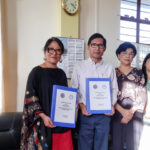As Nagaland wait for the completion of the two Medical Colleges in Kohima and Mon with the State government recently justifying the reasons for their delay, the people of Nagaland continue to live in a highly vulnerable health-care environment.
Similarly, Nagaland’s education system has always been a matter of debate especially during the time of HSLC and HSSLC results when most of the government schools produce a pass percentage of below 45%
Understanding the certain challenges and issues surrounding health care and education, a brief recollection on the projects where the World Bank has aided Nagaland is discussed below:
Nagaland Health Project (NHP)
In 2017, the Government of India, the Government of Nagaland and the World Bank signed a massive 48 million dollar credit agreement for the ‘Nagaland Health Project’ which aims to improve health services across the state.
The credit for the project was approved on December 19, 2016 from the International Development Association (IDA) with a maturity of 25 years, including a 5-year grace period.
According to the World Bank, the total cost of the project is 60 million dollars, with the IDA providing 48 million dollars, and the borrower i.e. the Government of India committing the remaining 12 million dollars.
The Nagaland Health Project aims to build 177 health facilities and 500 villages to enhance healthcare services over the six-year project as the closing date of Nagaland Health Project is March 31st, 2023.
There are two components of this multimillion dollar health project. The first component is community action for health and nutrition. It will empower communities to oversee, manage and improve health and nutrition programs and their utilization. Component 2 for health system development aims to support improvements in the management and delivery of health services.
According to reports, the project will directly benefit about 600,000 people while complementing the existing systems and mechanisms involving communities under the National Health Mission.
Nagaland Enhancing Classroom Teaching and Resources (NECTAR)
On 22nd February 2021, a $68 million project titled, ‘Nagaland Enhancing Classroom Teaching and Resources (NECTAR)’ was signed between the Government of India (GoI), the Government of Nagaland (GoN), and the World Bank to enhance the governance of schools across Nagaland as well as to improve teaching practices and learning environments in select schools.
This $68 million loan from the International Bank for Reconstruction and Development (IBRD) has a final maturity of 14.5 years including a grace period of 5 years. The actual project, according to the World Bank, is worth $85 million and thus, the remaining $17 million will be committed from the Government of India.
Directorate of School Education (DoSE), State Council of Educational Research and Training (SCERT), Nagaland Board of School Education (NBSE), and Samagra Shiksha State Implementation Society (SIS), as well as School Management Committees (SMCs) / School Management and Development Committees (SMDCs) are the implementing agencies.
Key components of this project involve strengthening and improving the school management systems, enhanced teaching and learning environment; technical assistance, finance ongoing monitoring, impact evaluation, and third-party assessments of project activities and outcomes.
According to reports, 15 out of 44 government higher secondary schools have been selected to transform it into composite schools, “the Lighthouse Schools,” offering nursery school to higher secondary level education.
The progress on the NECTAR and the impact it has made is yet to be seen and identified but a project like Nagaland Health Project which will close on March 31 of next year leaves room for thorough analysis.



